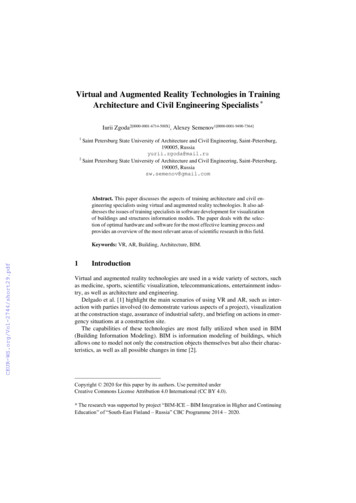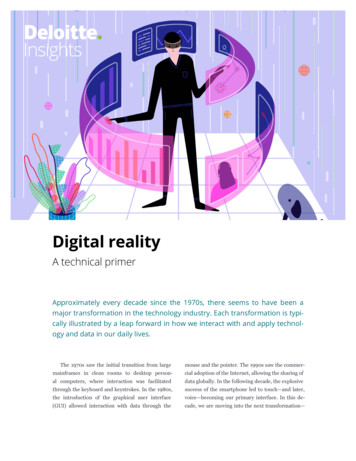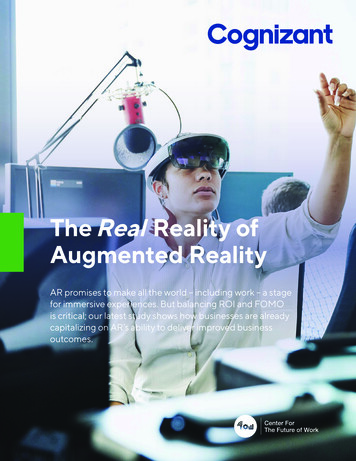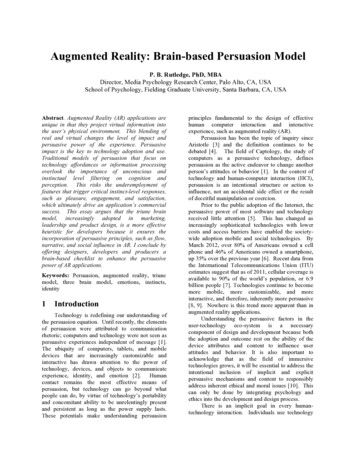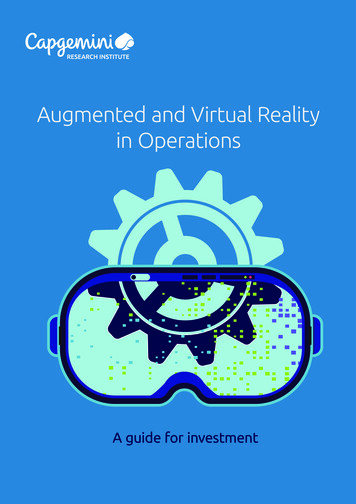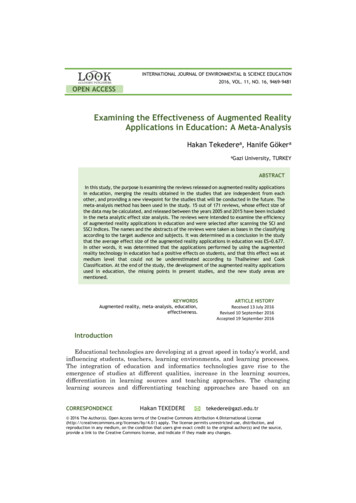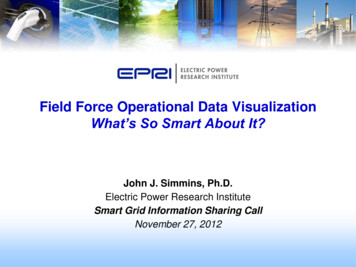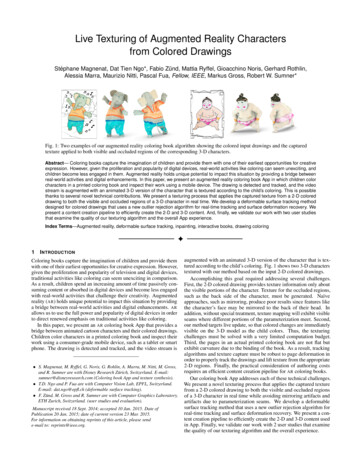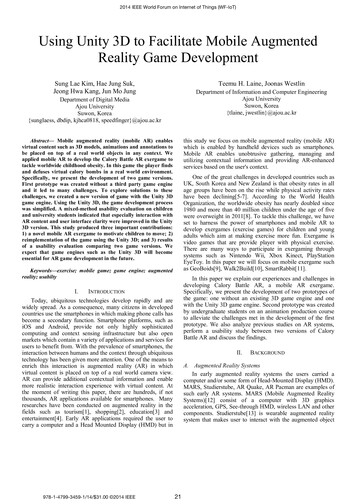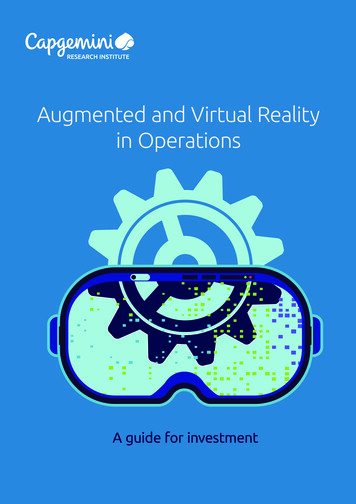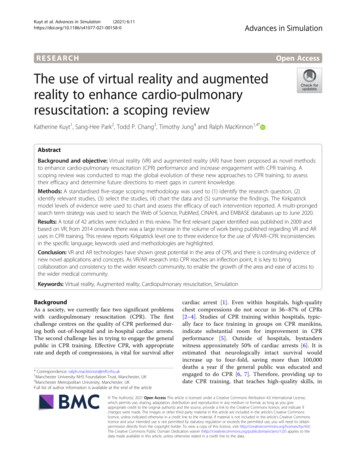
Transcription
European Journal of Science and Mathematics EducationVol. 8, No. 1, 2020 , 1-5Using mobile augmented reality to enhancing students’ conceptualunderstanding of physically-based rendering in 3D animationTiantada Hiranyachattada1,* and Kampanat Kusirirat2Department of Animation and Digital Media, Faculty of Science and Technology, Bansomdejchaopraya Rajabhat University,Bangkok, 10600, Thailand.2 Department of Animation and Digital Media, Faculty of Science and Technology, Bansomdejchaopraya Rajabhat University,Bangkok, 10600, Thailand.For correspondence: bmafueng@hotmail.com1,*Abstract :Physically-based rendering (PBR) concept is widely use nowadays in 3D rendering works, this concepts interested inthe ray of light for describes the interaction of light and materials. Understanding the principles of PBR can be easier toadjust shader parameters to be realistic, react correctly to changes in lighting condition and also giving the same resultseven in different 3D rendering software. In Shading lighting and rendering (SLR) subject which PBR concepts becomeimportant concept instead the ‘old style rendering’ it was found that students are unable to clearly understandconcepts of PBR. According to the problem, in this research bringing mobile augmented reality (AR) to be a media fordemonstrate PBR concepts for students. The sample were 35 students from Department of Animation and DigitalMedia, Bansomdejchaopraya Rajabhat University. The results found that students understand the PBR concepts andcan adjust the PBR shader paremeters to be realistic assess from students pre-test, post-test scores and studentshomework. The mobile AR application media were usable for students and suitable to be a learning media in 3Danimation assess form students’ response.Keywords: shader, 3D animation, PBR, augmented realityIntroduction3D rendering works has been being developed rapidly nowadays from the advances in physics,mathematics and computer science as can be seen from 3D animation and 3D games. Physically-basedrendering (PBR) is a method of shading and rendering that interested in the ray model of light as itdescribes the interaction of light and surface matter to be similar in virtual worlds. The keycharacteristics of PBR is energy conservation rule which means reflected ray is never brighter than thevalue it had when it first affect the surface (Substance Academy, 2019). Physically-based rendering(PBR) concepts are widely use nowadays in 3D rendering works togather with shader which is acomputer program that used for calculate shading such as the production of light, darkness, andcolors (Claudia Doppioslash, 2019).To adjusting the shader parameters in 3D animation works can be divide into 2 types: ‘old stylerendering’ which is parameters can be flexible and freely to adjust that can give unrealistic resultsdepend on shader artist and ‘PBR’ concepts rendering which is a newer concepts that focus on thephysics to light. Understanding the PBR concepts can be easier to adjust shader parameters to berealistic same as in the virtual world, react correctly to changes in lighting condition and also givingthe same results even in different 3D rendering software.At present, learning 3D animation this concept is not used widely use especially in Shading lightingand rendering (SLR) subject, was one of the important subject which have focused on shader, lighting,
2European Journal of Science and Mathematics Education Vol. 8, No.1, 2020and rendering which PBR concepts become important concept instead the ‘old style rendering’. It wasfound that students are unable to clearly understand PBR concepts and misunderstanding eachparameter values.As the problem mentioned, to making students understand PBR concepts in this research bringingaugmented reality (AR) technology via moblie phone which believe that the use of AR technologymedia can improve aspects of learning also physical phenomenon such as light and can be apply withAR technology in many form such as animation or virtual labatory (Jennifer L et al., 2015) todemonstrate PBR concepts in 3D animation for students in SLR subject and provide learingingexperience and knowladge to be understood by the students (M A Muchtar et al., 2016) for 3Danimation works.Mobile AR application media design and creationAfter identifying the learning problems in SLR subject, we will creating moblie AR application to be alearning media for students, the moblie AR application was developed by using softwaredevelopment life cycle whice are software specification, software design, software implementationand testing (Langer, Arthur M., 2018) with Unity (Unity Technologies, 2018 ; Rod Lopez, 2014) andVuforia (Vuforia , a PTC Technology, 2018) . The mobile AR application begins with the virtualworld object detection of the examples objects after the object in the real world has been detected themoblie AR application will display the 3D model of the objects and its PBR parameters value. Themobile AR application system creation as shown in figure 1.Figure 1. Crating mobile AR application with UnityMethod and Classroom demonstrationThe method used in this research was experiment method with one-group pretest posttest design. Inmethodology, the pretest was first assinged to the subject to evaluate student’s knowledge in shaderadjustment that students had lerned from pre-ruquisit subject. After finish the pretest, thedemonstration begin with giving the real object then students will use the mobile AR application toscan the example objects with their mobile phone until the mobile AR application display the 3Dmodel of the real object in PBR concepts and PBR key parameters. After finished demonstration, thepost-test was administered to measure the effect of learning AR media according to the examplesgiven also in each weeks of the study the lecturer will give students homework in order to validatethe understanding and continuously implement the knowledge. The learning framework of PBRconcepts as shown in figure 2 and the mobile AR application as shown in figure 3.PBR shaderadjustmentpre-testClassroom PBR shaderdemonstration withmobile AR applicationPBR shaderadjustmentpost-testFigure 2. Learning frameworkValidation afterlearning by assignhomework
European Journal of Science and Mathematics Education Vol. 8, No. 1, 2020Figure 3. mobile AR application interfaceResultsThe 35 students sample were from Department of Animation and Digital Media,Bansomdejchaopraya Rajabhat University, Bangkok, Thailand, in the 1st semester of academic year2019 selecting by purposive sampling methods. For the pre-test, the students’ score in average werelower than 50% of full scores which mean students cannot adjust the shader parameters in PBRconcepts as can be seen from material that look unrealistic. The student’s pre-test and post-test scoresas shown in table 1.Table 1. Statistical data of students’ conceptual understanding score in PBRPre-testPost-testobjectsNMean (Std.Dev)Mean (Std.Dev)Concrete (5 points)352.14 (0.85)4.43 (0.50)Aluminium (5 points)352.11 (0.80)4.57 (0.50)Plastic (5 points)352.17 (0.66)4.51 (0.51)For the post-test, students’ scores were higher than the pre-test scores. The results presented that thescores were increasing more than 50% from 2.14 to 4.43, 2.11 to 4.57 and 2.17 to 4.51. Moreover,students can adjust the shader parameters in PBR concepts [8] correctly and understand the PBRconcept clearly from visualization though 3D objects also can tell the difference between ‘old stylerendering’ and PBR concepts rendering. The students’ pre-test and post-test result examples as shownin figure 4.(a)(b)(c)Figure 4. Like-for-like comparison between non-PBR and PBR from student’s pre-test and post-test(a) concrete (b) aluminium and (c) plasticFor validating students’ knowledge, in each week of the SLR subject, the lecturer will assignhomework for students which were 3D animation scene such as exterior scene and interior scene also3
4European Journal of Science and Mathematics Education Vol. 8, No.1, 2020grade student’s homework by rubrics score. In table 2 shown the students homework scores and infigure 5 shown the students 3D animation scene homework examples.Table 2. Student’s homework scoresNWeek-TopicsMean (Std.Dev)1 – Exterior small scene (10 points)359.11 (0.80)2 – Exterior scene (10 points)358.71 (0.75)3 – Interior scene (10 points)358.40 (1.14)4 – Interior scene (10 points)358.37 (1.14)Average score8.64 (0.95)The student’s homework scores shown that student’s average scores in each week were higher than80% and students can apply shader parameters in PBR concepts with different 3D animation scenes.(a)(b)*(c)*(d)*Figure 5. Student’s homework examples in (a) and (b) exterior scene (TurboSquid, 2018),(c) interior scene (Solid angle, 2018) and (d) interior scene (Mographplus, 2018)After using mobile AR application to demonstrate PBR concepts in 3D animation, 35 students givetheir responses from questionnaires (Irwansyah, F et al., 2018) towards the use of mobile ARapplication. The results as shown in table 3.Table 3. Students’ response towards the use of mobile AR application by questionnaireTopicsMean (Std.Dev)Learning outcomeLearning objective4.44 (0.50)GoodIncreasing students learning motivation4.56 (0.50)Very goodSuitable to be applied in the process of learning PBR4.38 (0.55)GoodAR ApplicationAR application interface4.34 (0.48)GoodThe usage of AR application4.47 (0.51)GoodAverage4.45 (0.51)GoodThe students’ response shown that the mobile AR application can meet the learning objectives andusable for students is this subject. The increasing students learning motivation topic had the highestscores at 4.56 which mean AR media was interesting and can be attracted for students and AR
European Journal of Science and Mathematics Education Vol. 8, No. 1, 2020application interface had the lowest score at 4.34 which mean the application interface must beimprove to be more human friendly and better design.Conclusion and DiscussionBased on the demonstration and the results, the conclusions were: mobile AR application can makestudents understand the concept of PBR though 3D model which the most important features of ARcould make students can rotate the 3D model freely, making them easier to see the 3D model fromvarious perspectives. Students have better observation and analyzing skills, can compare the PBRmodel parameters with the real object, so students can learn and tell the differences and can adjust theshader parameters for 3D animation. Hence, this media gets positive responses from students andsuitable to be applied in the process of learning PBR for 3D animation or other 3D animationrendering concepts in the future.AcknowledgementsThis research was supported by Research and Development Institute and Faculty of science andtechnology, Bansomdejchaopraya Rajabhat University, Bangkok, Thailand.ReferencesArnold Renderer, (2018), Autodesk Arnold Renderer https://www.arnoldrenderer.com, (accessed October 2018)Chao, J., Chiu, J., DeJaegher, C., & Pan, E. (2015). Sensor-Augmented Virtual Labs: Using Physical Interactions with ScienceSimulations to Promote Understanding of Gas Behavior. Journal Of Science Education And Technology, 25(1), 16-33.Doppioslash, C, (2019), What is a , (accessed December 2018)Epic Games, (2018). Physically Based Materials g/Materials/PhysicallyBased (accessed April 2018)Irwansyah, F., Yusuf, Y., Farida, I., & Ramdhani, M. (2018). Augmented Reality (AR) Technology on The Android OperatingSystem in Chemistry Learning. IOP Conference Series: Materials Science And Engineering, 288, 012-068.LANGER, A, (2018). GUIDE TO SOFTWARE DEVELOPMENT. (pp. 1-200). [Place of publication not identified]: SPRINGER.Lopez, R, (2019). Physically Based Shading in Unity 5: A Primer – Unity Blog, ed-shading-in-unity-5-a-primer, (accessed October 2018)Muchtar, M., Syahputra, M., Syahputra, N., Ashrafia, S., & Rahmat, R, (2017). Augmented Reality for Searching PotentialAssets in Medan using GPS based Tracking. Journal Of Physics: Conference Series, 801, 1-6.Solid Angle, (2018). Comprehensive Introduction to Arnold 5 for Maya, uction-to-arnold-5-for-maya, (accessed September 2018)Substance Academy, (2019). The PBR Guide - Part 1 on Substance Academy, uide-part-1 (accessed March 2018)TurboSquid, (2018), Shelby 3D Models for Download https://www.turbosquid.com/3d-model/shelby (accessed October 2018)Unity Technologies. (2018). Getting Started with Vuforia Engine in Unit ingstarted-with-vuforia-in-unity.html, (accessed March 2018)Vuforia , a PTC Technology, (2018), Vuforia Developer Portal https://developer.vuforia.com/ (accessed October 2018)5
development life cycle whice are software specification, software design, software implementation and testing (Langer, Arthur M., 2018) with Unity (Unity Technologies, 2018 ; Rod Lopez, 2014) and Vuforia (Vuforia , a PTC Technology, 2018) . The mobile AR application begins with the virtual
